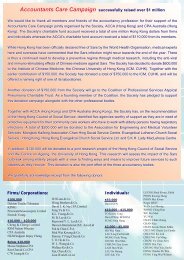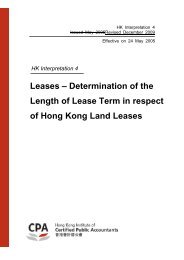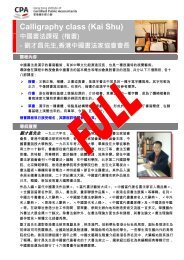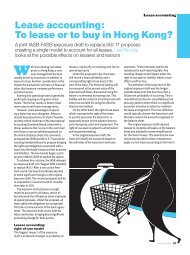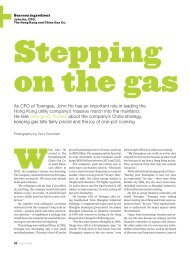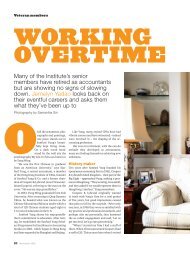Update No. 124 - Hong Kong Institute of Certified Public Accountants
Update No. 124 - Hong Kong Institute of Certified Public Accountants
Update No. 124 - Hong Kong Institute of Certified Public Accountants
Create successful ePaper yourself
Turn your PDF publications into a flip-book with our unique Google optimized e-Paper software.
Planning Activities<br />
The Overall Audit Strategy (Ref: Para. 7-8)<br />
PLANNING AN AUDIT OF FINANCIAL STATEMENTS<br />
A8. The process <strong>of</strong> establishing the overall audit strategy assists the auditor to determine, subject<br />
to the completion <strong>of</strong> the auditor’s risk assessment procedures, such matters as:<br />
The resources to deploy for specific audit areas, such as the use <strong>of</strong> appropriately<br />
experienced team members for high risk areas or the involvement <strong>of</strong> experts on<br />
complex matters;<br />
The amount <strong>of</strong> resources to allocate to specific audit areas, such as the number <strong>of</strong><br />
team members assigned to observe the inventory count at material locations, the<br />
extent <strong>of</strong> review <strong>of</strong> other auditors’ work in the case <strong>of</strong> group audits, or the audit<br />
budget in hours to allocate to high risk areas;<br />
When these resources are to be deployed, such as whether at an interim audit stage<br />
or at key cut<strong>of</strong>f dates; and<br />
How such resources are managed, directed and supervised, such as when team<br />
briefing and debriefing meetings are expected to be held, how engagement partner<br />
and manager reviews are expected to take place (for example, on-site or <strong>of</strong>f-site),<br />
and whether to complete engagement quality control reviews.<br />
A9. The Appendix lists examples <strong>of</strong> considerations in establishing the overall audit strategy.<br />
A10. Once the overall audit strategy has been established, an audit plan can be developed to<br />
address the various matters identified in the overall audit strategy, taking into account the<br />
need to achieve the audit objectives through the efficient use <strong>of</strong> the auditor’s resources. The<br />
establishment <strong>of</strong> the overall audit strategy and the detailed audit plan are not necessarily<br />
discrete or sequential processes, but are closely inter-related since changes in one may result<br />
in consequential changes to the other.<br />
Considerations Specific to Smaller Entities<br />
A11. In audits <strong>of</strong> small entities, the entire audit may be conducted by a very small engagement<br />
team. Many audits <strong>of</strong> small entities involve the engagement partner (who may be a sole<br />
practitioner) working with one engagement team member (or without any engagement team<br />
members). With a smaller team, co-ordination <strong>of</strong>, and communication between, team<br />
members are easier. Establishing the overall audit strategy for the audit <strong>of</strong> a small entity<br />
need not be a complex or time-consuming exercise; it varies according to the size <strong>of</strong> the<br />
entity, the complexity <strong>of</strong> the audit, and the size <strong>of</strong> the engagement team. For example, a<br />
brief memorandum prepared at the completion <strong>of</strong> the previous audit, based on a review <strong>of</strong><br />
the working papers and highlighting issues identified in the audit just completed, updated in<br />
the current period based on discussions with the owner-manager, can serve as the<br />
documented audit strategy for the current audit engagement if it covers the matters noted in<br />
paragraph 8.<br />
The Audit Plan (Ref: Para. 9)<br />
A12. The audit plan is more detailed than the overall audit strategy in that it includes the nature,<br />
timing and extent <strong>of</strong> audit procedures to be performed by engagement team members.<br />
Planning for these audit procedures takes place over the course <strong>of</strong> the audit as the audit plan<br />
for the engagement develops. For example, planning <strong>of</strong> the auditor's risk assessment<br />
procedures occurs early in the audit process. However, planning the nature, timing and extent<br />
<strong>of</strong> specific further audit procedures depends on the outcome <strong>of</strong> those risk assessment<br />
© Copyright 8<br />
HKSA 300 (December 2012)



